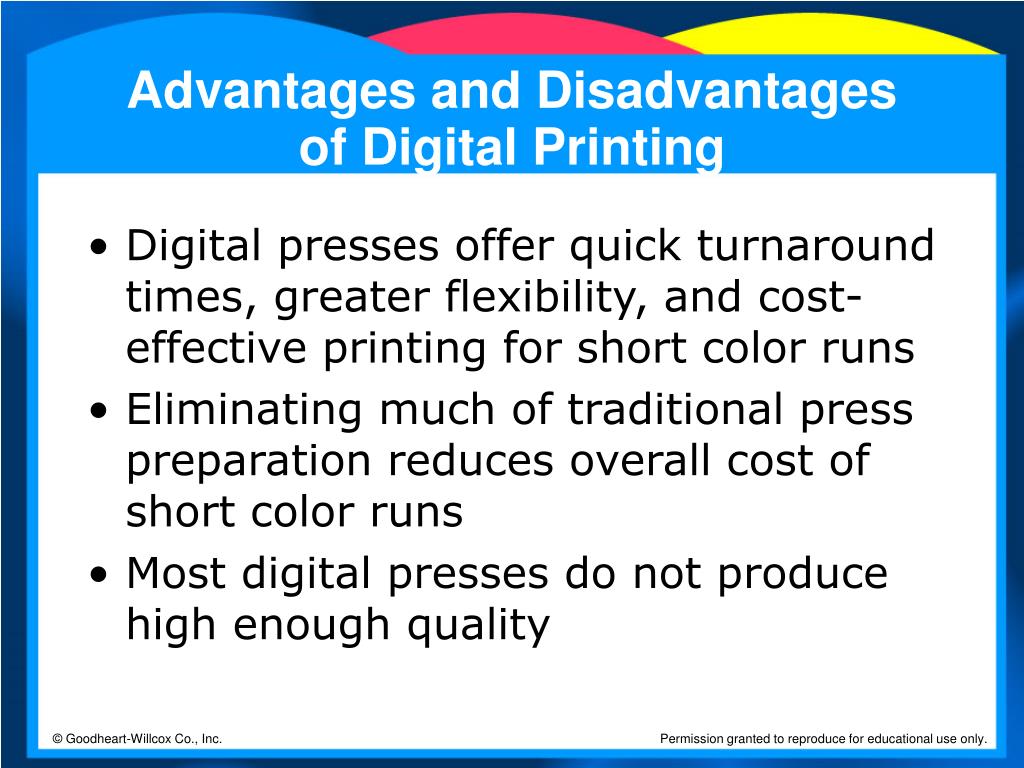Examine This Report on Digital Printing
Examine This Report on Digital Printing
Blog Article
All about Digital Printing
Table of ContentsDigital Printing Things To Know Before You BuyThe Digital Printing IdeasHow Digital Printing can Save You Time, Stress, and Money.Some Known Facts About Digital Printing.Digital Printing - An OverviewThe Buzz on Digital Printing
Variable data printing, such as straight mail with individualized codes and addresses, is preferably suited for electronic printing. Digital fast printing only requires 4 steps of layout, review, printing and binding to get every little thing done. Digital quick printing has an unparalleled advantage: print on demand.According to PMMI, electronic printing enables brand names and manufacturers to respond quickly to customer demands while enhancing the supply chain, lowering warehousing price and waste, and delighting in faster time to market. That all noises excellent, yet just how does this innovation do all that? The significant differentiator of these modern technologies is that there are no set up charges and no plates with digital printing.
The Ultimate Guide To Digital Printing
According to Wikipedia, the best difference between digital printing and typical methods such as lithography, flexography, gravure, or letterpress - Digital Printing is that there is no demand to change printing plates in digital printing, whereas in these analog printing approaches the plates are repetitively changed. This causes quicker turnaround time and lowers cost when making use of electronic printing.
Digital printing is very adaptable, so it's simple to make adjustments to the package style quickly. It all goes back to the plates.
With traditional printing approaches, short-run printing is simply not possible. Because an excellent layout can make or break your product, digital printing regularly produces high-quality, clear and colorful graphics each time.
Digital printing is the process of printing digital-based photos straight onto a variety of media substrates. There is no need for a printing plate, unlike with offset printing. Digital data such as PDFs or desktop posting documents can be sent out straight to the electronic printing machine to publish on paper, picture paper, canvas, textile, synthetics, cardstock and other substrates.
The 3-Minute Rule for Digital Printing
According to PMMI, digital printing permits brand names and producers to react swiftly to consumer demands while boosting the supply chain, lowering warehousing cost and waste, and enjoying faster time to market. That all audios fantastic, however just how does this innovation do all that? The major differentiator of these modern technologies is that there are no set-up costs and no plates with electronic printing.
According to Wikipedia, the biggest difference in try these out between digital printing and conventional approaches such as lithography, flexography, gravure, or letterpress is that there is no demand to change printing plates in digital printing, whereas in these analog printing approaches the plates are consistently changed. This leads to quicker turnaround time and reduces expense when using digital printing.

All About Digital Printing
With standard printing approaches, short-run printing is simply not possible. Due to the fact that a great layout can make or break your item, electronic printing consistently creates top notch, clear and vivid graphics each time.

According to PMMI, electronic printing permits brand names and producers to react quickly to client needs while boosting the supply chain, decreasing warehousing expense and waste, and appreciating faster time to market. That all sounds wonderful, but exactly how does this innovation do all that? The significant differentiator of these technologies is that there are no set-up fees and no plates with digital printing.
The Best Strategy To Use For Digital Printing
According to Wikipedia, the best distinction in between electronic printing and standard approaches such as lithography, flexography, gravure, or letterpress is that there is no demand to change printing plates in electronic printing, whereas in these analog printing techniques the plates are continuously changed. This leads to quicker turnaround time and lowers expense when utilizing digital printing.
Speedy manufacturing indicates obtaining your product to market faster. It additionally suggests it's much easier and faster to make modifications later on, when you transform a recipe, add a SKU, or develop seasonal product packaging. Digital printing is extremely flexible, so it's very easy to make modifications to the package design promptly. It all returns to home plates.

The Definitive Guide to Digital Printing
Digital printing is the process of printing digital-based pictures directly onto a range of media substratums. There is no need for a printing plate, unlike with offset printing. Digital documents such as PDFs or desktop publishing documents can be sent directly to the electronic printing press to publish on paper, image paper, canvas, material, synthetics, cardstock and various other substrates.
Report this page